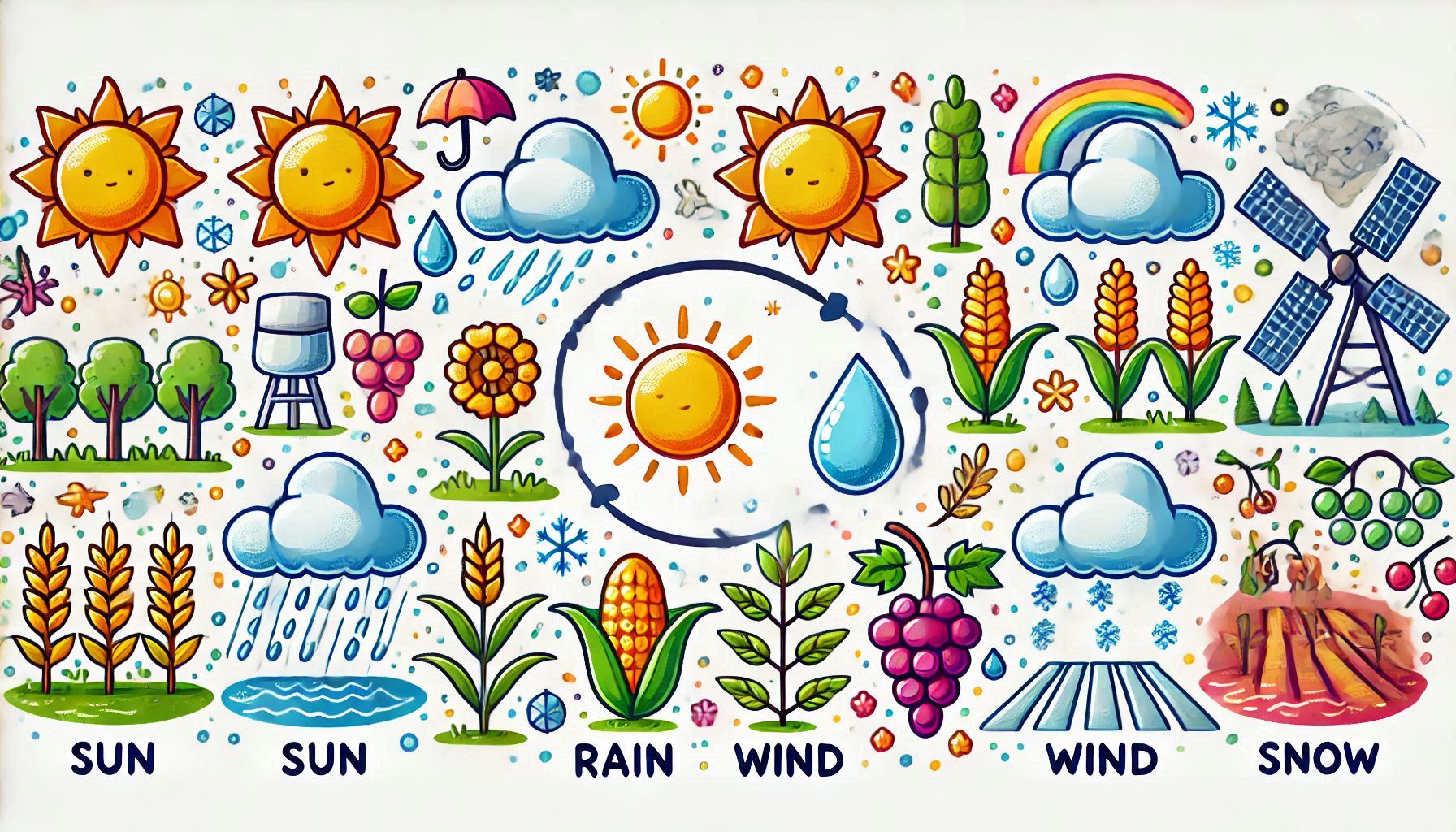Factors affecting crop production – climatic – edaphic – biotic- physiographic and socio economic factors One Liner
Internal Factors (Genetic)
- Crop yields are influenced by the genetic makeup of plants.
- High-yielding ability in plants is a desirable genetic trait.
- Early maturity in crops can be a result of genetic factors.
- Genetic resistance to lodging ensures crop stability in harsh conditions.
- Drought tolerance in crops is a genetically inherited trait.
- Flood tolerance can also be genetically encoded in plants.
- Salinity tolerance in crops is influenced by genetic makeup.
- Some crops are genetically resistant to insect pests and diseases.
- Oil and protein content in crops are determined by genetic traits.
- The fineness or coarseness of grains is a genetically controlled trait.
- The sweetness and juiciness of crop straw are influenced by genetics.
- Genetic factors are less impacted by environmental variables.
- Genetic improvements in crops lead to better yields and disease resistance.
- Genetic makeup plays a role in the overall quality of harvested crops.
External Factors
A. Climatic Factors
- Climatic factors account for nearly 50% of crop yield variation.
- Precipitation (rainfall, snow, hail, dew) is crucial for crop growth.
- The total amount and distribution of rainfall affect crop choice.
- Heavy rainfall areas are ideal for crops like rice, tea, and coffee.
- Low and uneven rainfall requires drought-resistant crops like sorghum.
- Excessive rainfall can reduce crop yields by waterlogging the soil.
- Distribution of rainfall is more important than total rainfall for crop growth.
- Temperature affects the growth and development of crops.
- Most crops thrive in temperatures between 15°C and 40°C.
- Temperature influences the distribution of crop plants.
- Cardinal temperatures (minimum, optimum, maximum) determine crop growth.
- Germination and crop growth are highly temperature-sensitive.
- Humidity impacts crop transpiration and water requirements.
- A relative humidity of 40-60% is ideal for most crops.
- High humidity can promote pest and disease outbreaks in crops.
- Solar radiation is essential for photosynthesis in plants.
- Photosynthetically Active Radiation (PAR) is critical for biomass production.
- Photoperiodism affects the flowering of certain crops.
- Short-day crops (e.g., rice) need less daylight, while long-day crops (e.g., barley) require more.
- Wind velocity can impact crop health, nutrient transfer, and pollination.
- Moderate winds (4-6 km/h) benefit crops, but strong winds can cause damage.
- Wind aids in the natural dispersal of pollen and seeds.
- High wind speeds can increase soil erosion and crop damage.
- Atmospheric gases like CO2 are vital for photosynthesis.
- Nitrogen fixation in crops is enhanced by atmospheric nitrogen.
- Excess gases like SO2 and CO can harm plant growth.
B. Edaphic (Soil) Factors
- Soil moisture is essential for plant growth and photosynthesis.
- Water availability in soil depends on its texture (e.g., clay retains more water than sandy soil).
- Soil aeration is crucial for root respiration and nutrient absorption.
- Soil temperature affects germination and root growth.
- Soil mineral content provides essential nutrients for crops.
- Organic matter in soil improves texture, moisture retention, and nutrient availability.
- Soil organisms, like microbes, decompose organic matter and fix nitrogen.
- Soil pH affects nutrient availability, with neutral pH being optimal for most crops.
- Acidic or alkaline soils can hinder plant growth due to toxic substances.
- Soil organisms like earthworms enhance soil fertility through organic matter decomposition.
- Soil water availability influences chemical and biological processes.
- Soil aeration supports the decomposition of organic matter.
- Soil temperature regulates microbial activity and nutrient availability.
- Soil organic matter improves soil texture and water retention.
- Soil reactions (pH levels) influence plant health and nutrient uptake.
- Soil moisture availability between field capacity and permanent wilting point is vital for crops.
C. Biotic Factors
- Plants compete for nutrients, water, and light, influencing crop yields.
- Intercropping (e.g., cereals and legumes) often results in higher yields due to complementary benefits.
- Weeds compete with crops for resources, affecting yield.
- Parasitic weeds like Striga affect crops such as sugarcane.
- Soil fauna, like nematodes and insects, can benefit or harm crops.
- Insects and nematodes damage crops and reduce yields.
- Pollinators like bees help increase crop yields through cross-pollination.
- Earthworms aerate the soil, improving water drainage and fertility.
- Grazing animals, such as cattle and goats, can damage crops.
- Pests, like aphids, can reduce crop yields through feeding and disease transmission.
- Crop rotation can reduce pest and disease pressure.
- Natural predators help control pest populations, benefiting crops.
D. Physiographic Factors
- Topography affects crop growth by influencing water runoff and erosion.
- Steep slopes can cause soil erosion, leading to nutrient loss.
- Altitude impacts temperature and precipitation, influencing crop selection.
- Higher altitudes typically have cooler temperatures and increased rainfall.
- Mountain slopes with low sunlight intensity may reduce crop yields.
- Wind exposure on slopes can reduce crop yields due to increased evaporation.
- Coastal areas are affected by saltwater and wind, influencing crop selection.
- Plains tend to have more stable conditions for farming than hilly terrains.
- Well-exposed slopes to sunlight and wind are favorable for some crops.
- Altitude changes in crop-growing areas may require different crop varieties.
E. Socio-Economic Factors
- Farmers’ inclination toward certain crops depends on economic viability.
- Access to farming technology and tools affects crop production.
- Availability of skilled labor influences crop yields.
- Government policies and subsidies impact farming decisions.
- Economic conditions of farmers (e.g., small vs. large scale) determine resource allocation.
- Financial constraints can limit access to quality inputs like seeds and fertilizers.
- The choice of crops is often influenced by market demand and prices.
- Economic stability helps farmers invest in crop production and infrastructure.
- Educational programs on modern farming techniques improve crop yields.
- Access to irrigation systems enables higher crop productivity in dry regions.
- Crop breeding programs aim to develop high-yielding and pest-resistant varieties.
- Societal preferences, like cultural food habits, influence crop selection.
- The availability of credit for farmers helps in purchasing farming inputs.
- Crop insurance policies reduce the risks associated with crop failure.
- The economic impact of crop production affects national food security.
- Socio-economic factors determine the adoption of new farming practices.
- Urbanization can lead to reduced agricultural land for crop production.
- The availability of transport infrastructure influences market access for crops.
- Socio-political stability affects the farming environment and investments.
- Socio-economic status affects the ability to implement modern agricultural technologies.
- Trade policies impact crop exports and influence local crop prices.
- Changes in global trade and climate agreements can affect local crop production.









